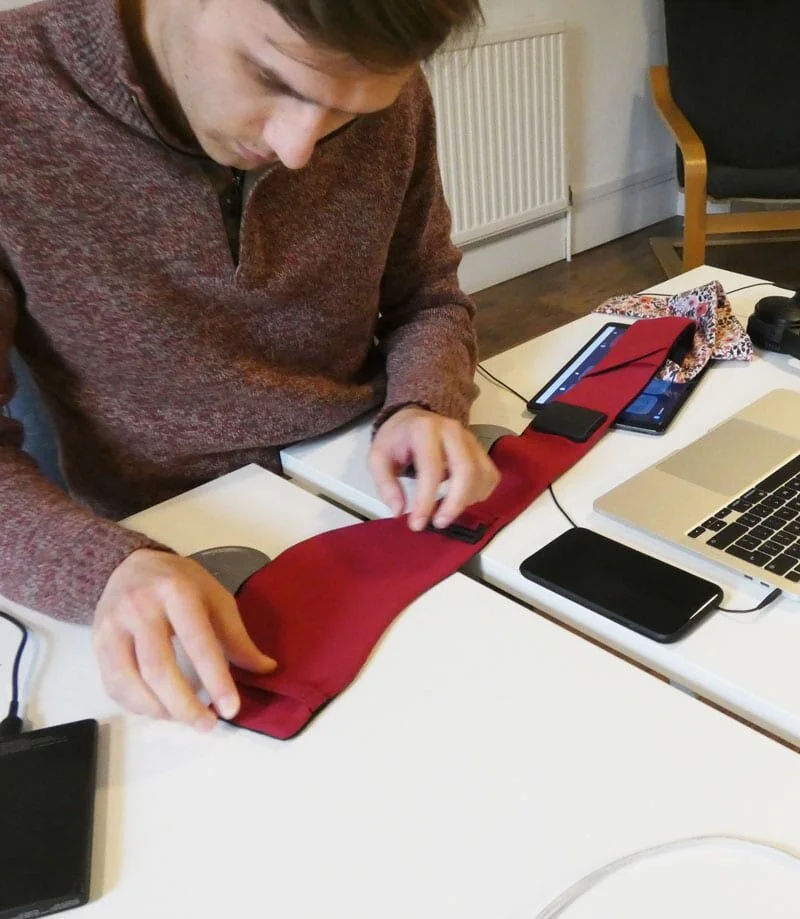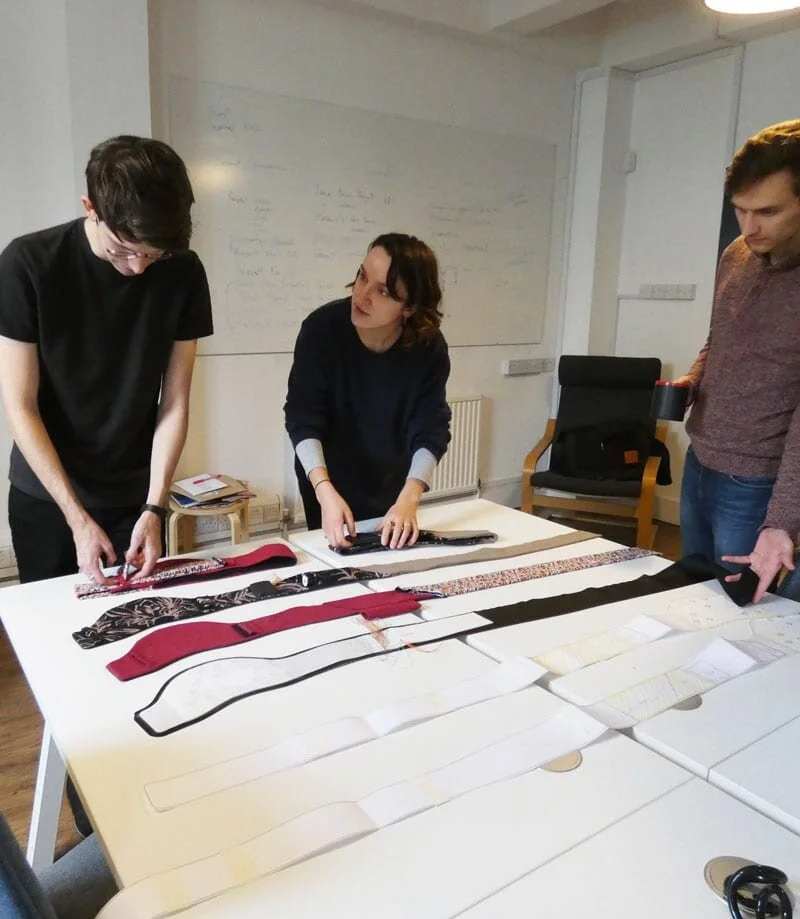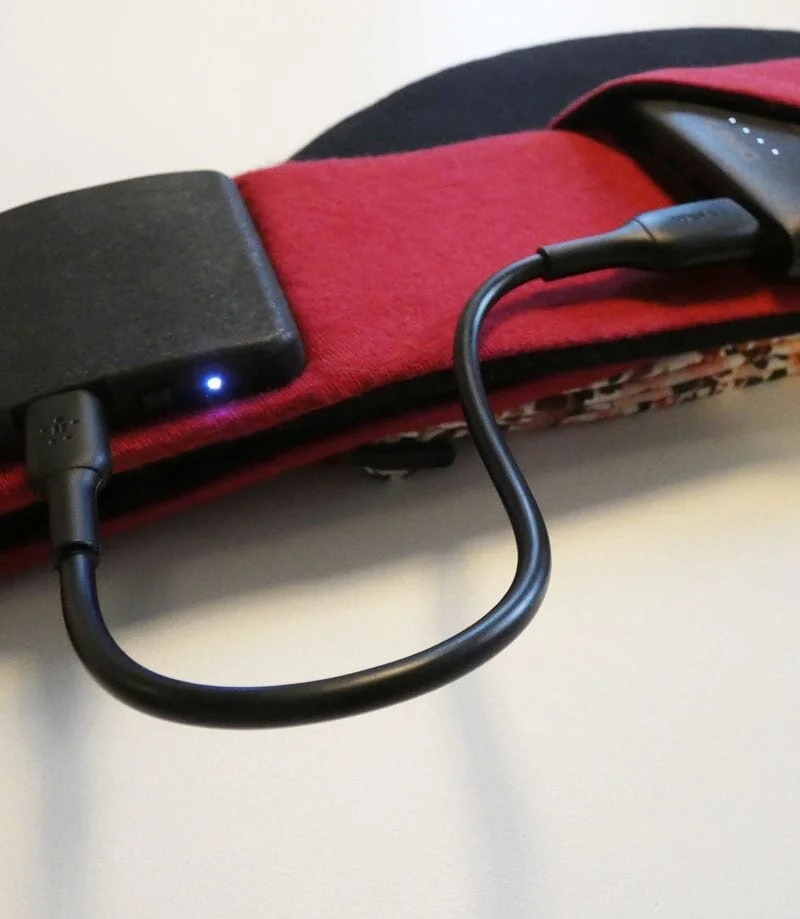Transforming a wearable pain-management belt from concept into a functional prototype - a case study by Thrive Wearables
About Thrive
Thrive are a team of designers, developers and engineers with a mission to solve global health challenges with the power of technology innovation, connected devices and data processing. They are the leading wearable technology design and development consultancy and they work with global companies, academic partners, charities and individuals to turn great ideas into world changing wearables. Read more about Thrive.
The Client
Moonly is a European start-up with a genuinely pioneering idea. They’re growing fast thanks to the passion and focus of their founders, as well as the confidence of their seed investors. Their mission is to provide a new, wearable solution for pain management for menstruation and endometriosis. This innovative solution was developed in close collaboration with Thrive from the early development of the concept.
The Challenge
Moonly brought their ideas and research to Thrive, with the aim of identifying the right technology to deliver an unobtrusive therapeutic belt that can be worn under clothing to provide relief for users through the day and testing for feasibility. The next steps were producing a Concept Prototype for user testing, marketing and initial manufacture validation. Moving from an idea to a tangible product needs a carefully managed approach. Thrive’s team also needed to move the Mymoony belt into a position where it could be user tested in a rapid timeframe.
The Solution
Thrive engaged with Moonly from the early stages, taking the concept forward through a series of carefully managed development steps. Once the team had a deep understanding of Moonly’s aspirations, we used our technical capabilities to make the dream a reality. First, Thrive used Technology Strategy research as a launchpad to develop a Feasibility Prototype, testing each component before embarking on the creation of a fully functional Concept Prototype.
This was Moonly’s first opportunity to experience their idea as a physical entity with the right form factor that can be fully tested with users. Alongside the belt, an android application was created, making up a fully functional prototype. The app also tracks data from user testing, giving Moonly valuable insights into how people will use the product.
From initial conversation, through three development stages, to the successful delivery of high quality functional prototype, it has taken just under 12 months.
In the course of this work proprietary IP was created and Moonly are now in the process of obtaining a patent.
Thrive will continue to work with Moonly on their groundbreaking, conversation-starting product, now at the Engineering Validation stage, having established a European manufacturing base for the initial rollout of the Mymoony belt. Moonly will be shipping the first mymoony products in 2021.
TESTIMONIAL
“Thrive met our expectations and more. They listened and fully understood our vision with a detail-oriented approach. Without the team and their experience, we could not have developed our prototype, and their technical expertise and clarity in their approach made the journey a pleasure to make together. ” - Asma Hassoune, Founder, Moonly
Q&A with the Thrive Product Engineer behind this project
Zima Pawulska is a member of the Thrive tech team, a Product Development Engineer and Project Lead. She holds a BSc in Product Design and an MSc in Robotics and Autonomous Systems. Recently, she’s been working with Moonly to create a prototype of a belt which provides pain relief for menstruation and endometriosis.
Zima, tell us more about the project you’ve been working on recently.
Moonly came to us with a really innovative concept. They wanted to address pain from endometriosis and menstruation. Between 50% and 70% of people who menstruate suffer from permanent or recurring dysmenorrhea, which can affect all ages, it impacts mood, general wellbeing, and also productivity and attendance at school and in the workplace. It’s a really common (1 in 10 women in the UK are affected) and sometimes severe problem, but treatment options remain pretty limited to pharmacological solutions. These aren’t ideal, as they come in the form of hormones or painkillers which can create stresses on other organs and metabolism imbalances. Moonly’s solution is a non-invasive therapeutic belt device, which delivers targeted heat and massage to the abdominal region.
We kicked off the development with Technology Strategy research work, where various potentially relevant technologies were identified and analysed against the product requirements to assess practical feasibility. This resulted in a proposed system design and identification of key technical risks and areas for testing and validation, which became the focus of Feasibility and System Prototype development. We collaborated with Moonly and used feedback from user testing to refine the product requirements and inform the next stages of development.
We then used learnings and outcomes from the previous stages, which we consolidated into the development of a Concept Prototype. This combined the technical system requirements with miniaturised electronics and soft goods designs, which we developed working closely with Moonly. The result was a representative prototype, demonstrating the product’s core value proposition.
The Moonly project has been a really enjoyable project to develop, because of the Thrive team and the Moonly team themselves. It has also been so well received, and it’s the first experience I have of developing a product that is very close to manufacture and being commercially available. So that’s quite amazing.
We are now working with Moonly to bring the product into the initial phase of production and Engineering Validation, refining the product and design for manufacture. It’s my first introduction to femtech, which feels very pertinent to the recent International Women’s Day.
What do you define as femtech, and why is it a special interest for you?
Femtech products address the specific health and wellbeing concerns of women, which have historically been really overlooked, and that has led to health inequality bias. Endometriosis takes an average of 7.5 years to diagnose. I am a huge advocate for gender diversity and equality in technology, it’s great to see so much recognition and activity happening in this space at the moment. It’s also really exciting and humbling to have the opportunity to be involved in the development of products in this area that will go on to have real, positive impact and continue to break gender barriers in health and wellbeing.
You are a Product Development Engineer – what led you to this career path?
It was a bit of an unconventional journey! When I first started my higher education I was very art focused. I started by doing my art foundation and specialised in 3D sculpture, which drove me into more functional art and design which, in turn, drove me to study product design for my undergraduate degree at university.
From that point on, I started to get more and more technical and further away from the visual art side. I did a sandwich degree, so I had a year in industry as part of that, where I worked for an industrial computing company designing custom computer systems for businesses.
Then in my final year of university I went down a more technical route and ended up doing a BSc. It was at that point I started to focus more towards health related design. I designed a prosthetic leg as my undergraduate degree project. I really enjoyed that, so I think that set off a real interest and passion in health-focused design, or design that has a bit more of a positive impact, let’s say, rather than just nice things that people like to have. From then on I really wanted to focus on designing things that were going to bring a positive impact to people, or on an environmental scale. And I decided I wanted to explore the technical side a bit more! I had a good foundation in mechanical design and product design, and I wanted to go more into electronics and technologies because it’s such a big thing at the moment. I went to study my Robotics MSc and again throughout that I kept it really health and wellbeing focused and my project for that was, again, a prosthetic, but this time it was a robotic hand. Once I had finished my MSc, within a few months I was at Thrive!
What do you find your biggest challenge in the industry?
Because everything in technology is so fast moving, it can be a real challenge to keep up to speed with what’s going on in the world around you. That is also one of the most exciting aspects, having to constantly learn and develop rather than getting stuck in what you know.
What was your experience of university and education, did you find that you were encouraged and nurtured or very much left to do things independently?
Both independent and nurtured. The nature of design is that you’re left to your own devices, given the building blocks and then it’s your responsibility to take what you’ve learned and turn it into a concept or a product so there definitely was a lot of being left to your own devices, especially at MSc level, but I suppose that’s pretty standard at that level of education.
Do you have any advice for women and girls who want to come into the health tech industry?
If you’re passionate about it, pursue it! Working in technology is challenging and can be stressful, but when you love what you do the drive and motivation come naturally. As a woman in engineering and technology, there are even more challenges and biases to overcome. I’m extremely lucky to have a network of driven and inspiring women around me, whose support and encouragement has been invaluable to me. Identify and connect with those around you, celebrate and elevate each other at every opportunity!






